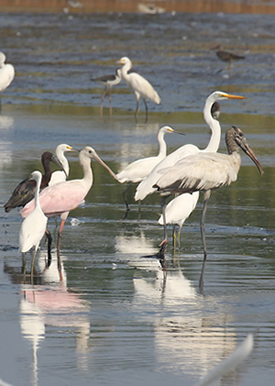Species and Statuses

Accounts From The State Wildlife Action Plan (SWAP)
The colonial wading birds of South Carolina are a diverse and fascinating group of birds. The purpose of this website is to provide information about the ecology, conservation, and management of wading birds in South Carolina. Fourteen species of wading birds (Orders: Pelecaniformes and Ciconiiformes) are known to nest in South Carolina (Table 1).
The terminology used to describe wading birds can be confusing. In North America, the term “wading bird” is used to refer to storks, herons, and egrets. In other areas of the world, shorebirds such as oystercatchers and sandpipers are often referred to as wading birds. The sites where groups of wading birds nest are referred to as colonies or rookeries. Sites where groups of wading birds rest during the day or overnight are called roosts, and groups of feeding wading birds are referred to as flocks or foraging aggregations. Foraging is the term used to describe feeding activities.
Species Table. Colonial wading bird species that are regularly observed in South Carolina. CConservation status from State Wildlife Action Plan (SWAP 2015).
| Common Name | Scientific Name | Conservation Status |
|---|---|---|
| Black-crowned night heron | Nycticorax nycticorax | Highest Priority |
| Cattle egret | Bubulcus ibis | Not classified in SWAP |
| Glossy ibis | Plegadis falcinellus | Moderate Priority |
| Great blue heron | Ardea herodias | Moderate Priority |
| Great egret | Casmerodius albus | High Priority |
| Green heron | Butorides virescens | Highest Priority |
| Little blue heron | Egretta caerulea | Highest Priority |
| Reddish egret | Egretta rufescens | Highest Priority |
| Roseate spoonbill | Platalea ajaja | Moderate Priority |
| Snowy egret | Egretta thula | Moderate Priority |
| Tricolored heron | Egretta tricolor | High Priority |
| White ibis | Eudocimus albus | Highest Priority |
| Wood stork | Mycteria americana | Highest Priority |
| Yellow-crowned night heron | Nyctanassa violacea | Highest Priority |
Additional information about the status of wading birds in South Carolina can be found at the State Wildlife Action Plan website.
The "All About Birds" website by the Cornell Lab of Ornithology provides excellent species accounts.
Summaries of the history, ecology, and conservation of wood storks can be found in the Multi-Species Recovery Plan for South Florida (PDF) and the Wood Stork Conservation and Management for Landowners Brochure (PDF).
SCDNR Wading Bird Program
585 Donnelley Dr.,
Green Pond, SC 29446, wadingbirds@dnr.sc.gov
